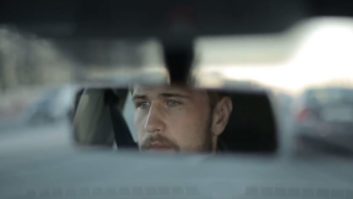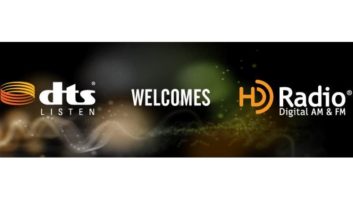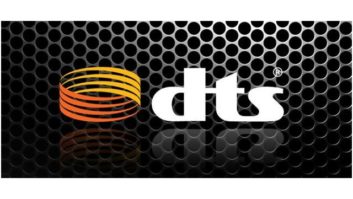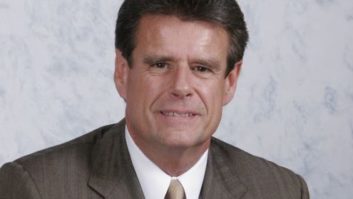Columbia, Md.- The National Radio Systems Committee (NRSC) has endorsed iBiquity’s DAR technology for terrestrial FM broadcasts and has encouraged the FCC to adopt the technology as the nation’s digital FM standard.
The endorsement of the in-band on-channel (IBOC) technology keeps iBiquity on track for a radio-station rollout in six major markets beginning in May or June and the availability of home and car receivers early in 2003, said iBiquity president Robert Struble.
The NRSC, jointly sponsored by the CEA and NAB, based its recommendation on the results of NRSC-defined field, lab and listening tests conducted by independent test labs and monitored by NRSC representatives, Struble said. AM-band test results will be submitted to the NRSC in December, and NRSC will issue its recommendations early next year. Struble expects the tests to verify that AM IBOC also delivers what it promises.
To underscore its progress, iBiquity said Alpine, Delphi, Kenwood, Visteon and one other aftermarket autosound company will stage the first-ever demonstrations of prototype car radios with built-in or outboard DAR tuners. The tuners will be based on a Texas Instruments DSP chip sitting on an iBiquity-developed credit-card-size module.
Only Visteon’s head unit will feature on-board DAR; the others will feature an add-on module. For its part, Kenwood will also demonstrate a home receiver.
The TI chip is an off-the-shelf DSP loaded with iBiquity’s IBOC software. Because the chip is more powerful than needed, TI will develop a less expensive derivative version that will be available in production quantities around July for DAR receivers targeted for a CES 2003 launch, iBiquity said.
To eventually lower the expected initial $100-$150 price premium that DAR-equipped radios will command, Philips is developing an IBOC-specific ASIC solution that will be about half as expensive to manufacture as a multipurpose DSP solution, iBiquity added. It’s targeted for early- to mid-2003 availability in production quantities.
Although the radios on display will be prototypes, they won’t be receiving over-the-air broadcasts from a Las Vegas radio station. That’s because iBiquity’s radio module won’t be far enough along in development to include an RF front end that filters and cleans up an RF signal, said marketing director Dave Salemi. Instead, digital music will be piped into the prototype radios by a cable connected to IBOC exciters, he explained. It will be the first time that the standard’s PAC codec will be demonstrated at CES, he added. The AAC codec was used in previous CES demos.
Like last year, however, a local FM station will broadcast an AAC-based digital signal that will be played back in iBiquity’s booth, and in demo vans roaming the streets, through first-generation receiving equipment, Salemi said.
Tests of the PAC codec are in the works, but ‘we expect no issues,’ Struble noted. ‘The supplementary tests will be done to fill out the record,’ but the NRSC ‘is satisfied it’s time to move aggressively,’ he said.
At April’s NAB convention, the three top transmitter manufacturers -Harris, Nautel, and BE – plan to take orders for DAR broadcast equipment, enabling some stations to begin installing the equipment in May and June to seed the market for receivers, Struble said. The company is focusing its marketing efforts on the top six early adopter markets, and by the end of 2002, its goal is to expand adoption to radio stations that reach 50 percent of radio listeners in those markets. In the New York City market, that could be as few as 10 stations depending on who signs up, he noted.
The targeted markets are Chicago, Los Angeles, Miami, New York, San Francisco, and Seattle.
In four years, Struble predicted, one half of all commercial and public stations will be digital.
For this chronology to occur, the FCC will have to act in the first or second quarter of 2001 to endorse iBiquity’s technology as the nation’s stand for terrestrial digital broadcasting on the existing AM and FM bands, and Struble said he expects this to happen. FCC staff is ‘receptive’ to picking iBiquity’s technology, he added.
The FCC might then issue a notice of proposed rulemaking to set detailed rules for implementing the technology. They could include digital-signal power levels and the like. Those standards could be adopted by late next year, Struble said.
Among other things, the NRSC found that the digital FM technology delivers ‘greatly reduced impact of multipath interference (for mobile, portable and fixed receivers alike), superior resistance to co-channel and adjacent-channel interference, support for enhanced data services, [and] improved audio quality’
Previously, Struble also said the tests showed that the technology:
- -has ‘no meaningful impact’ on a station’s existing analog signal, enabling radio stations to broadcast simultaneously in analog and digital on their assigned frequencies to ensure that consumers’ existing radios don’t become obsolete overnight.
- -delivers digital coverage comparable to analog ‘even at 1 percent of analog FM power’ even in difficult reception markets such as Manhattan and San Francisco.











